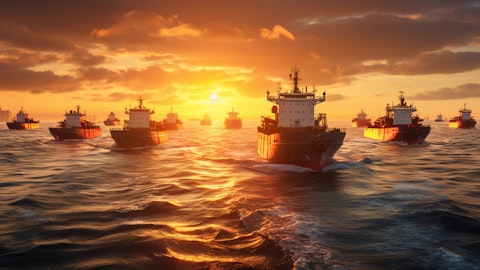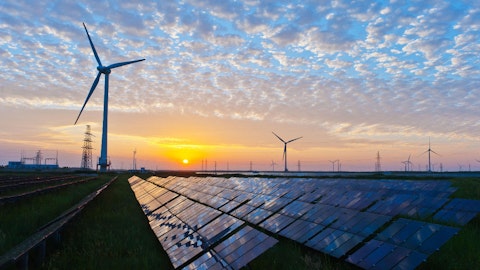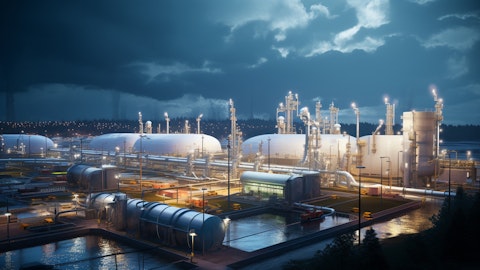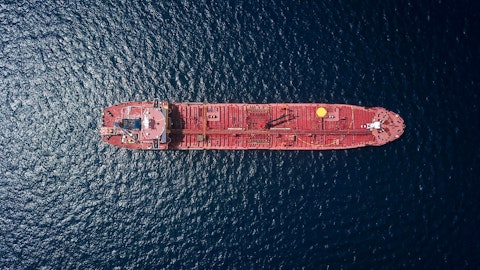I think this liquidity, ironically, the S&P market is different. The S&P market is prices have gone up, prices are reflecting and the S&P market itself is reasonably liquid.
Greg Lewis: Okay. Super helpful. And I know we’ve been talking a lot about the Suez Canal here. Could you talk a little bit maybe Cam or James or what you guys are seeing kind of in the Panama Canal. I mean it seems like water still low there. It seems like that could be more of maybe a longer-term issue that could be impacting rates in the Atlantic.
James Doyle: Cam, would you like to take this?
Cameron Mackey: Sure. Thanks, Greg. It absolutely is affecting rate structures in the Atlantic. Our analysis of the situation is it’s exacerbated by El Nino, the Panamanians are trying to redirect water into the lake. The earliest we can see any improvement is later in the second quarter, but that is an educated guess and not something that we can plan on or forecast with any certainty. So we just don’t know what it would take between the rainfall and the redirection of other water into the lake to allow the Panamanians to increase transits but that’s our best guess.
Operator: We proceed with Samuel Bland with JPMorgan.
Sam Bland: The first question is, I guess, on the Red Sea disruption, we’ve seen your very big reaction in LR2 rates but less of one in MRs, is that what you’d expect to see, given the sort of trading patterns of each? Or I don’t know, could the MRs go up in the coming weeks? And let’s maybe take that one and then I’ll ask the second one after that. Thank you.
Robert Bugbee: Yes, I think it’s happened exactly as we would expect. First of all, yes, there are less LR2s. And when this thing, when it first strikes, everybody wants to go to that vessel that carries the maximum cargo. And then what happens after that, it starts getting absorbed around, and we’ve seen the MR market actually move up now in the last couple of weeks. And that’s moved up against the U.S. Gulf refinery situation plus the preparation for Chinese New Year. So that’s like a very bullish sign and you’ve starting to see cargoes getting split. So in the same way it took a little time for the LR2s to actually move. It takes a little time for the space to be filled for one to another way between the MRs and the LR2.
Sam Bland: Okay. Understood. And the second question is on the net fleet growth graph on Slide 13. I just saw on the footnote, there’s this assumption of 30% slippage across 2024 to 2027, which I guess we’re expecting those years to be good years. I can sort of see why you might get slippage in a band period, but why would we expect 30% slippage in what hopefully is going to be a strong market. Thank you.
James Doyle: Sam, you always get slippage at the end of the year on certain vessels, but there’s a lot of vessels in the order book that don’t have firm delivery dates. So there were a lot of vessels ordered maybe promising a Q4 delivery date in ’25 or Q2 or something like that in the later years and we just don’t have the specifics on it. So it’s our best estimate of when these vessels will deliver.
Operator: Our next question comes from Ken Hoexter with Bank of America.
Ken Hoexter: Robert or James, can you talk about kind of breakeven levels now, right? So you’ve gone down to 16,000 a day from 17,000 last quarter. I guess where do you see that trending? You’ve talked before about kind of getting that a little bit lower. Maybe just talk about where you think it is now.
Robert Bugbee: I think we’re happy to give the 16 and we’ll not talk about where we want to go. I think we’ll say that we are focused on reducing our breakeven levels. And to the extent that you are paying down debt and reducing your debt amortization and interest costs than that should happen. I think it’s better that we just say where they are rather than say, where they’re going to.
Ken Hoexter: Okay. And just a lot on this Red Sea discussion. Maybe talk a bit about, I guess, is the impact to rates now? Is it still somewhat isolated on certain lanes, is it just rates globally have adjusted? I just want to understand the process on kind of timing and how well spread out that the rate adjustment is now.
Robert Bugbee: All routes are up. That’s what’s so strong. The depth of breadth across the product space is very strong.
Ken Hoexter: Okay. And then, Robert —
Robert Bugbee: Many, many, many different routes. I mean, I’ve described some really crazy routes, the MRs. But inside of that, the Obviously, the Asia market has been stronger on the MRs and the U.S. Gulf is let’s say being the one that’s not so strong, even though it’s still very strong. But that’s because of the refinery turnarounds in Asia, even though it’s going through Chinese New Year has been assisted because talent is being drawn to Europe because of Europe situation. And frankly, I think we’re getting a little help from U.S. finally being tough on the sanction Russian oil and Russian trading ships. I think that’s good, too.
Ken Hoexter: I guess, Robert, if we thought forward and you were talking about the Red Sea reopening kind of in your base model, right, in terms of assumption on pricing. What happens in terms of if Russia and Ukraine at some point, the war will end, and you’ll get — what happens to those vessels? How quickly do they get reabsorbed into the market? I just want to understand timing.
Robert Bugbee: Yes, of course. But I mean if you’re looking for excuses to maintain your hold because you’re now worried about Russia, I doubt whether Russia, Panama and Middle East will all get sold together very shortly. And there is Russia, we can be slightly more certain on because it’s a phenomenon that’s sort of been embedded. That position just doesn’t seem to be getting any easier. As I said, the U.S. is getting tougher related to the sanction. Putin is showing no interest in slowing down and Ukraine at the moment is showing no interest in giving up. So we also still have to accept the longer we go through the curve and time here, the more that anyway, Russia going back, I don’t see how you go back to how it was before anyway.
And even if you go back a little bit, I don’t think that starts to affect things so much because you’ve got this aging of the fleet coming through, and then you’ve got the growth in other trades in the product market that have taken over. And I just can’t imagine that you’re going to go back to, oh, yes, that’s great. Thanks, Russia. Will Europe just take everything again.
Ken Hoexter: So just help me understand the last part of your kind of argument, right, is if you are assuming a base case or return in your rate assumption, at elevated rates, tell me again why you would not want to start locking in any charter out contracts? Is it that they just don’t adjust to where the market is in any relationship.
Robert Bugbee: You’re assuming, I’ve only talked about elevated rates related to the Middle East. I don’t think that the market is that elevated any longer and over was related to the Russian thing. I think that was sort of a little bit over extended. And the reason is this is because the rates are very, very high right now. The charter is sitting there saying, so these are not the rates. But let’s say, before all this happened, they ship would be $20,000 a day charter, for example. And right now, that vessel could earn, let’s say, $30,000, $35,000, $40,000 a day because of the elevated rate. The charterer hasn’t really moved. So now the calculation would be for a 2-year charter, the owner would want to have more rather than give the ship away at the front at such a big discount.
But the charter isn’t yet ready to pay that rate because the charter does not have the certainty with all the different changes in the new announcement every 10 minutes of whether those very heightened rates will continue for a long time. The same as nobody does. So therefore, it’s almost like no trade in, let’s say stock market length, the bid offer is just too wide right now. But that will settle down some point over the next 3 to 4 weeks, I would expect.
Operator: Our next question comes from Frode Morkedal with Clarksons Securities.
Frode Morkedal: Congrats for the strong quarter and even better first quarter. I guess coming back to the Red Sea, you talked a lot about it. And I appreciate the $60,000 figure if it opens up tomorrow. But I’m curious to hear your upside case should this continue, right? I guess we haven’t seen all ships that worked. So do you have any idea what the potential impact could be, how high rates could go should this last?
Robert Bugbee: Well, I know this guy in Norway. There is an analyst — this company called Clarksons. This Norwegian guy names is Frode. And he sort of said very early in the piece at the end of last year that we could see LR2 rates at over $100,000 a day in certain fixtures and that person has been right Frode. So I think we’ve done quite well following your guidance, right? So I don’t think we’re going to comment on the upside. Upside can take care of itself.
Frode Morkedal: Fair enough. I guess, you mentioned —
Robert Bugbee: Congratulations on your coal product.
Frode Morkedal: Thank you. My final question is just on the new trade lanes you mentioned. We all observed the standard routes. But curious to hear and what type of new routes do you see on the LR2s, for example, which are emerging.




